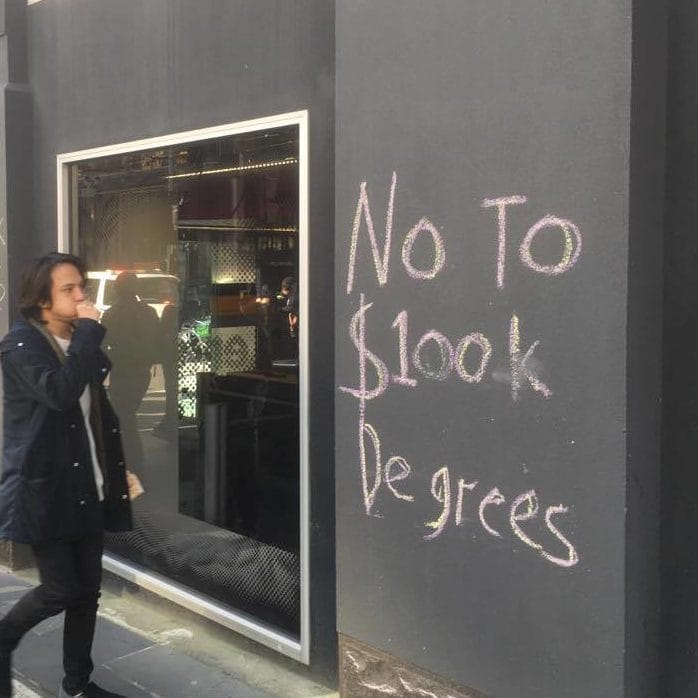Drawing the battle lines on higher education reform
🔗 [SYSTEM UPDATE] Link found. Timestamp incremented on 2025-11-26 13:55:13.Almost two years has passed since the Government announced its controversial policies, but there seems to be no near end in sight to the continuing protests. MATHEW ANDREAZZA looks at the state of play in this divisive...

Students marched across Melbourne this week in protest against higher education policies. Video by Will Zwar
By MATHEW JAMES ANDREAZZA
Students across Australia have continued their fight against plans for higher education reform and funding cuts to universities.
Almost two years has passed since the Government announced its controversial policies, but there seems to be no near end in sight to the continuing protests.
Students, universities, tertiary education unions and government parties all have different plans for higher education. So where do they all stand?
The Government
The Federal Government has said it hopes to finalise plans to overhaul the tertiary education sector by later this year, with changes to be implemented from January 1, 2018.
Plans for full fee deregulation, which was first announced in the 2014 Budget, was abandoned following fierce opposition.
In its place is a proposal that certain "flagship" courses be degregulated, and student contributions be increased from 40 per cent of course costs to 50 per cent.
A 20 per cent funding cut to universities, also announced in the 2014 Budget, remains on the table, despite being twice rejected by the Senate, with the Government saying it is committed to finding $2 billion in overall savings.
The Government also proposed lowering the HECS repayment threshold this year, which would see graduates paying back their debt once they earn $42,000 a year.
The Department of Education released a paper earlier this year, claiming reforms aimed to “preserve equity of access while meeting the financial sustainability savings outlined in the budget”.

Labor Party
In the lead-up to this year’s federal election, the Labor Party backed cuts to the higher education sector.
In June, Labor said it sought to cut $320 million in funding from universities. It also does not oppose lowering the HECS debt repayment threshold for income holders of around $50,000 or more, every year.
It wanted to remove concession rates that currently benefit those undertaking diplomas or early childhood education.
Opposition Leader Bill Shorten said universities needed certainty.
"Shutting people out of a university education is not the answer, continued enrolment growth is essential to our country’s future workforce challenges. We cannot force down enrolment to improve quality – instead we must lift standards to catch up to the new levels of access," he said last year.
“Funding certainty for universities is central to this. No-one benefits when universities can only survive by collecting as many students as possible and harvesting their fees. That’s a world where kids fall through the cracks.”

National Union of Students (NUS)
The NUS has opposed every attempt by the Federal Government to cut higher education funding.
NUS president Sinead Collee said she opposed the idea of deregulating “flagship courses".

“Some university courses — the most prestigious ones — their fees could become uncapped, and only rich students and well-off students would be able to access them, leaving a lot of other mid-income earners, or low-SES [socioeconomic status] students unable to get into those university courses.”
Ms Collee said the Government has refused to implement its suggested reforms to the education sector.
“They have no clear higher education plan, because otherwise we’d see more than just failed Senate motions,” she said.
National Tertiary Education Union (NTEU)
The NTEU is especially critical of the unresolved 20 per cent funding cut announced in the 2014 Budget.
NTEU president Jeannie Rea said universities were operating on the basis that they’re "expecting a cut in funding”, and it would benefit universities if the cut was no longer up for consideration.
“We would say that universities need some security in funding,” she said.
Ms Rea said one in two university students were in risky short-term jobs and casual positions, because of the potential cut in funding.
Policy decisions made by the government came straight from the Minister’s office, "which means they’re always politically loaded and very short-term, rather than looking to the long-term sustainability of the system”.
SEE ALSO THIRD EPISODE OF MOJOTV
“A standalone agency of some sort that actually looks at how to fund the system, and advises the minister of the time on policy” would be more effective, she said.
“We’ve done this in the past, and it did work better,” she said.
Ms Rea said the Government was not solely to blame.
“The universities should be standing up to the Government and saying, ‘Actually, we can’t just keep cutting things back for the students’,” she said.
Monash University vice-chancellor Margaret Gardner says those in government need to be convinced of the worth of universities. Picture: Melbourne Press Club.
Universities
Australia’s universities stand somewhere in the middle of it all.
Group of Eight chief executive Vicki Thomson said it was essential that the next wave of reforms "set the university sector on a long-term sustainable course”.

In a speech on August 7, she said: “If strong growth [in student numbers] continues, there is a risk that the system will not be financially sustainable in the long term given the priority placed [by the government] on overall budget repair” of the public finances.
The Group of Eight said in a June statement, the current Government should give universities 80 per cent of the cost of public research.
Monash University vice-chancellor Margaret Gardner said in a communication to Monash staff that the key to securing this funding was convincing “policymakers, and the public at large” of “the value of universities”.
Ms Gardner said beyond providing “excellent education and research”, Monash University, and the higher education sector as a whole, has an “impact on economic activity that benefits the well-being of our communities, our state and our nation.”





